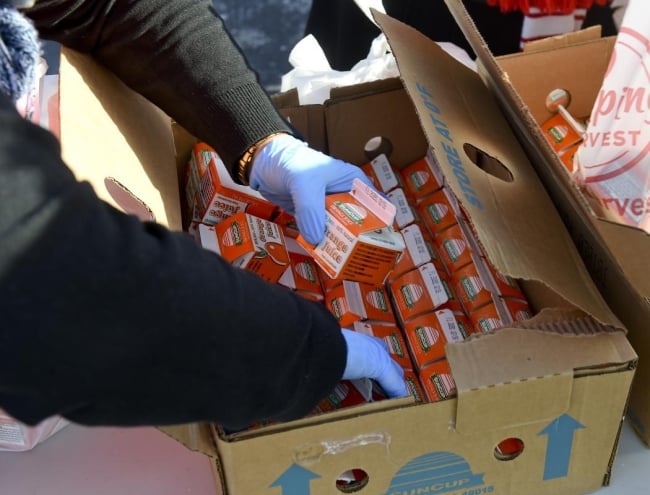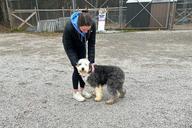You have /5 articles left.
Sign up for a free account or log in.

The NCES data shed new light on food insecurity at colleges. Some colleges and universities have hosted food drives to support food-insecure students, especially during the pandemic.
Photo by Ben Hasty/MediaNews Group/Reading Eagle via Getty Images
Over the past decade, universities and community organizations alike have increased their efforts to support students struggling to access basic needs like housing and food. But even as researchers tried to study how best to help those students, one significant hurdle stood in their way: no one knew exactly how many homeless or hungry students were out there.
From 2015 to 2021, Temple University’s Hope Center for College, Community and Justice, a student equity research center, published an annual #RealCollege Survey, which included rates of homelessness and food insecurity among college students. While it proved a useful window onto the issue, it was limited by the small number of colleges and universities that opted to participate—particularly in its early years.
That’s why some researchers began pushing the U.S. Education Department’s National Center for Education Statistics, a federal body dedicated to collecting data related to education, to track and publish information about student food insecurity and homelessness.
Sara Goldrick-Rab, who founded and led the Hope Center until leaving it in 2022 amid questions about her leadership, now works as a senior fellow at Education Northwest and an independent consultant. She and her colleagues asked the NCES to collect these data first in 2015 and again in 2017. Goldrick-Rab requested that NCES include questions about food insecurity and homelessness as part of the National Postsecondary Student Aid Study (NPSAS), which is conducted every three to four years and looks at how both undergraduate and graduate students finance their educations.
The request argued that nationally representative data about students’ access to basic needs—and how it connects to larger questions of college affordability—could open new doors for colleges trying to develop supports for their students and for researchers trying to dig into the causes and effects of housing and food insecurity.
“Scholars, practitioners and policy makers need additional data to confirm [the Hope Center’s] findings and create a clear national picture of the prevalence of food and housing insecurity among today’s undergraduates,” the letter said.
Goldrick-Rab also had her own goal—one that she didn’t spell out in the letter to NCES. She wanted critics—namely the university administrators, think-tank researchers and other skeptics who doubted that young people struggling with hunger and homelessness could even attend college—to finally believe there was a widespread problem of basic needs insecurity among the country’s higher ed institutions.
Now that wish has finally been granted. The latest NPSAS, which was publicly released in late July and features data from spring 2020—during the onset of the COVID-19 pandemic—surveyed over 100,000 students on their experiences with food and housing insecurity.
Over all, the findings corroborate something that basic needs researchers have long asserted: college students face higher rates of food and housing insecurity than the general population.
“The really big reason this is so important is these are experiences that are affecting millions of students and have been, I firmly believe, for the whole time,” said Goldrick-Rab. “But because the federal government didn’t collect data on them, those experiences were not considered legitimate.”
Report Findings
The details differ slightly from what the Hope Center found. According to the Hope Center’s analysis of the NCES data, 22.6 percent of undergraduates and 12.2 percent of graduate students experience food insecurity, while 8 percent of undergraduates and 4.6 percent of graduate students experience homelessness—somewhat smaller percentages than what the Hope Center’s fall 2020 survey revealed.
The NCES data show that rates of food insecurity are higher at for-profit institutions (32.9 percent), historically Black colleges and universities (38.8 percent), and tribal colleges and universities (35.5 percent) than they are for the general student population.
The 2020 NPSAS provides the first insight into rates of food and housing insecurity at for-profit colleges, which had not been featured in the Hope Center’s studies, according to Bryce McKibben, senior director of policy and advocacy at the Hope Center.
The survey also shows that the rate of food insecurity among white students is 16.6 percentage points lower than it is for Black students and 6.9 percentage points lower than it is for Hispanic students. Students who are parents and Pell Grant recipients also experience higher rates of food insecurity.
Similar trends can be seen in the data for homeless students, although parents have lower rates of homelessness than nonparents, and Hispanic students experience only marginally higher rates of homelessness than white students. Over all, 8 percent of students reported being homeless.
Kevin Kruger, president and CEO of NASPA: Student Affairs Administrations in Higher Education, said he is hopeful that the new data will help university leaders realize that homelessness and hunger aren’t problems that only impact community colleges or rural institutions.
“I think it’s easy to assume where you think these problems are, what the issues are. But it’s really a national problem. There may be more depth to it at certain kinds of institutions … [but] this cuts across all institutions,” he said.
The data also point to another phenomenon that basic needs researchers have long emphasized: that the cost of college goes well beyond tuition, fees and materials. Colleges can better serve students by informing them of what Goldrick-Rab and fellow researchers call the “real” price of attending, which includes housing, transportation and food.
Advocates believe the report could lead to increased funding, resources and support for basic needs programs—both within the university and at the state and local level. Many colleges have begun offering supports like food pantries, homeless liaisons and basic needs offices. But those are often small-scale programs, operating with minuscule budgets and only a few—if any—full-time staffers.
McKibben added that he hopes the data influence policy makers to reconsider how they support college students. The Supplemental Nutrition Assistance Program, or SNAP, is notoriously difficult for college students to access due to both eligibility requirements and the complexity of the application. He hopes the evidence that college students desperately need assistance could change that.
“The more we understand the depth, the more we can advocate for the resources necessary,” Kruger said.




